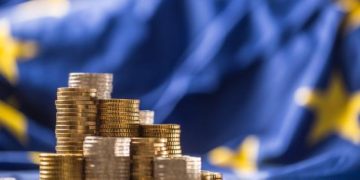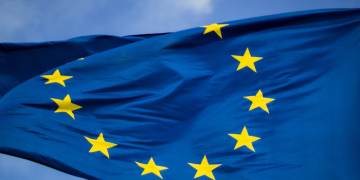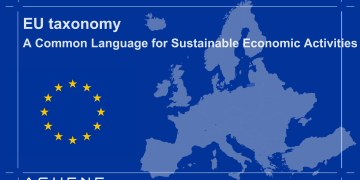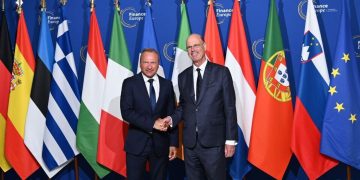Introduction
The eurozone enters the mid-2020s in a position defined by both resilience and fragility. A series of external shocks—from the pandemic’s long tail to the energy crisis triggered by geopolitical tensions—have reshaped the economic environment in which the European Central Bank (ECB) now operates. Although inflation has largely retreated from the historic highs of 2022 and 2023, the structural foundations of European growth remain under pressure. The euro, meanwhile, has embarked on a complex trajectory: appreciating against some major currencies while facing renewed volatility in global foreign exchange markets.
As policymakers navigate disinflation, slowing growth, a series of cautious rate cuts, and a competitive global environment, the eurozone’s macro-financial landscape has become a focal point for analysts and investors across the world. Understanding the euro’s recent trends requires a deep exploration of inflation dynamics, monetary policy evolution, structural economic challenges, and the underlying strengths of the currency union.
This article provides a comprehensive analysis of the eurozone economy as of 2025, offering a detailed examination of the forces shaping the euro and the ECB’s monetary stance, and projecting likely scenarios for the future.
1. Inflation Dynamics in the Eurozone
1.1 From historic highs to normalization
In 2022, eurozone inflation reached levels unseen in the history of the currency union, driven by soaring energy prices, supply chain bottlenecks, and pent-up demand. Annual inflation briefly exceeded 10% in some member states, deeply challenging the ECB’s credibility and forcing a rapid shift to policy tightening.
By 2024 and early 2025, the inflation landscape had changed dramatically. Headline inflation fell toward the ECB’s 2% target, driven largely by:
- Stabilization of energy prices after the shocks of 2022.
- Normalization of global supply chains, reducing goods price inflation.
- Cooling demand as tighter financial conditions filtered through the economy.
By 2025, eurozone inflation oscillated between 2.2% and 2.6%, close to the ECB’s medium-term target but still displaying a degree of stickiness, particularly in services.
1.2 Core vs. headline inflation
While headline inflation benefited from lower energy costs, core inflation told a more complex story. Services inflation remained elevated due to:
- Persistent labor market tightness,
- Wage increases negotiated to compensate for the real income loss during earlier inflation peaks,
- Structural factors such as demographic aging and a shift toward high-value, low-productivity-growth services.
Core inflation hovering above 2.5% created tension in ECB policy circles: the institution wanted to support growth but could not ignore underlying price rigidity.
1.3 Inflation expectations and credibility
One of the ECB’s victories during this turbulent period has been the anchoring of long-term inflation expectations. Unlike in the US, where inflation expectations occasionally diverged, European surveys (such as the ECB Consumer Expectations Survey) showed that households and firms broadly believed inflation would return to around 2% over the next three years.
This credibility provided the ECB flexibility to reduce rates cautiously without triggering fears of runaway inflation.
2. Economic Growth and the Eurozone Output Gap
2.1 A slow-growth environment
Growth in the eurozone has been one of the weakest among advanced economies in recent years. Structural challenges have constrained output:
- Low productivity growth
- High energy costs
- Labor shortages
- Fiscal fragmentation across the euro area
- Weak business investment
In 2024, GDP growth hovered around 0.5%. By mid-2025, forecasts indicated only modest improvement, with growth expected to range between 0.8% and 1.2% depending on global conditions.
2.2 The evolving output gap
Economists remain divided on whether the eurozone output gap—the difference between actual and potential output—is positive or negative. Some analyses suggest the economy is operating below potential, especially in manufacturing-heavy economies such as Germany and Italy. Others argue that potential output itself has declined, making the output gap appear smaller than it truly is.
Key contributors to potential output stagnation include:
- Aging demographics, reducing the labor force.
- Slow adoption of digital technologies compared to the US and parts of Asia.
- Investment bottlenecks tied to regulatory fragmentation across the euro area.
- A solar-to-wind energy transition that requires time before productivity benefits manifest.
The implication is clear: Europe’s structural growth challenge will persist unless bold reforms materialize.
2.3 Divergence within the eurozone
Heterogeneity across member states complicates the ECB’s job. While countries like Spain exhibited relatively robust growth in 2024–2025 due to strong services and tourism demand, Germany faced a recessionary environment created by industrial decline and weak external demand.
This divergence raises the question of whether one-size-fits-all monetary policy is still optimal for a deeply diverse economic bloc.
3. ECB Monetary Policy: The Move Toward Rate Cuts
3.1 The tightening cycle (2022–2023)
During the inflation crisis, the ECB raised rates at an unprecedented pace. The deposit facility rate climbed from -0.5% in mid-2022 to over 4% by late 2023. This dramatic tightening cooled inflation but also significantly weakened credit demand and investment.
3.2 The shift to easing (2024–2025)
By early 2024, signs of a slowing economy and disinflation prompted the ECB to begin cutting rates, albeit cautiously. Rate cuts in 2024 and early 2025 lowered the deposit rate to around 2.5–2.75%.
But crucially, this easing campaign was not aggressive like previous cycles. Instead, policymakers insisted on a meeting-by-meeting approach, signaling caution due to:
- Persistent service inflation
- Wage growth momentum
- The risk of geopolitical disruptions
- Exchange rate sensitivity (more cuts could weaken the euro excessively)
3.3 The monetary policy dilemma
The ECB faces a classic dilemma:
- Cut rates too quickly, and inflation could accelerate again.
- Cut too slowly, and the eurozone risks falling into prolonged stagnation.
The compromise has been gradualism—small cuts, spaced out, and always data-dependent.
3.4 Transmission of monetary policy
The effectiveness of ECB rate cuts varies significantly across the eurozone.
- In countries with flexible mortgage markets (e.g., Spain), monetary easing quickly reduces household debt burdens.
- In fixed-rate mortgage markets (e.g., France, Germany), the effect is slower.
- Bank lending conditions remain tight, as lenders remain cautious amid low growth and high regulatory pressure.
As a result, rate cuts have had only a modest stimulative effect.

4. The Euro’s Recent Trends and Drivers
4.1 A currency supported by disinflation and policy stability
The euro strengthened in several phases between 2024 and 2025, reflecting:
- Improved confidence in the ECB’s inflation management
- Stabilization of Europe’s energy supply
- Weaker expectations for aggressive US Federal Reserve tightening
- Capital inflows into euro-denominated assets
The euro’s appreciation has been particularly pronounced against currencies of energy-dependent economies.
4.2 Interest rate differentials
A major driver of the EUR/USD pair remains the interest rate differential between the ECB and the Federal Reserve. When the Fed paused rate hikes earlier than expected, the dollar weakened, allowing the euro to climb. However, because the ECB’s easing was more cautious than markets anticipated, the euro retained support.
4.3 Market expectations and speculative positioning
Futures markets have shown that investors increasingly see the eurozone as moving away from the crisis narrative of the early 2020s. The euro has also benefited from:
- Reduced sovereign debt fragmentation risk
- Stronger fiscal coordination via EU-level recovery funds
- Continued internationalization of euro-denominated green bonds
These developments help position the euro as a stable currency despite the region’s growth problems.
5. Risks and Headwinds Facing the Eurozone
5.1 Geopolitical instability
Europe remains vulnerable to global disruptions:
- US–EU trade tensions could flare up.
- Energy supply risks remain a long-term concern.
- Uncertainty in Eastern Europe may impact investor confidence.
These external shocks could weaken both the economy and the currency.
5.2 Wage-price dynamics
While wage growth helps support household purchasing power, it also risks keeping inflation elevated. If wage inflation remains above productivity growth, the ECB may need to delay further rate cuts, which markets may interpret negatively.
5.3 The possibility of renewed fragmentation
Although European sovereign spreads have remained contained, any political shock—such as instability in Italy, France, or Germany—could reignite concerns about eurozone cohesion.
5.4 A strong euro dampening exports
The euro’s appreciation helps reduce import inflation but makes European exports less competitive, particularly in manufacturing-intensive economies. Germany, already undergoing industrial restructuring, is especially exposed.
6. Opportunities for the Eurozone
Despite its challenges, the eurozone holds several structural advantages:
6.1 Green transition leadership
Europe’s aggressive shift toward renewable energy and carbon neutrality offers long-term opportunities:
- A robust green bond market
- Leadership in environmental regulations
- Investment in clean technology
These strengths could make euro-denominated assets increasingly attractive.
6.2 Rising global demand for currency diversification
As some countries seek to reduce reliance on the US dollar, the euro remains the most credible alternative. The euro’s share of global reserves has shown signs of stabilizing and could even grow if Europe successfully enhances financial integration.
6.3 The digital euro
A well-managed digital euro could:
- Increase cross-border payment efficiency
- Reduce reliance on non-European payment systems
- Strengthen the eurozone’s monetary sovereignty
Though still in development, the digital euro may eventually reinforce the euro’s global appeal.
Conclusion: The Eurozone’s Path Forward
As of 2025, the eurozone stands at a pivotal juncture. Inflation has moderated, but core pressures remain. Growth is fragile, yet not collapsing. The ECB is cautiously easing, but structural challenges limit the impact of monetary policy. The euro is stronger than expected, benefiting from improved credibility and global diversification trends.
The region’s future will depend on:
- The ECB’s skill in navigating disinflation without stifling growth
- Structural reforms that address Europe’s productivity slowdown
- Fiscal coordination among member states
- Continued investment in the green and digital transition
The euro is neither in crisis nor in a position of unchecked strength. Instead, it is entering a new era—defined by stability, cautious optimism, and the ongoing need for strategic economic transformation.




























